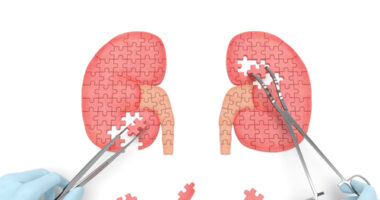Careful Donor Evaluation Can Improve Alport Patients’ Kidney Transplant Outcomes

Kidney transplantation in those with Alport syndrome may have better patient and graft survival rates compared to patients with other causes of end-stage renal disease (ESRD). Available evidence also indicates that careful evaluation of potential donors, particularly for mutations in key Alport genes, is required.
The review study, “Renal transplantation in patients with Alport syndrome: patient selection, outcomes, and donor evaluation,” appeared in the International Journal of Nephrology and Renovascular Disease.
Sex and genotype (a person’s set of genes) influence the risk and timing of ESRD in Alport patients, making some subsets more likely for dialysis and kidney transplantation than others.
In people with the X-linked form of the disease (XLAS), its most common form, 50% of men reach ESRD by age 25 and 90% by age 40. In contrast, only 12% of women develop ESRD before age 40, but the probability of ESRD increases to nearly 30% by age 60 and 40% by age 80.
Patients with autosomal recessive Alport syndrome (ARAS) typically reach ESRD by age 40. In turn, autosomal dominant Alport syndrome (ADAS) usually progresses less aggressively than the other forms, with recent studies reporting a median renal survival of 70–80 years.
Clifford E. Kashtan, a pediatric nephrologist from the University of Minnesota Medical School, evaluated the factors influencing ESRD risk and timing in Alport patients, and assessed transplant outcomes, selection of donors as well as post-transplant anti-glomerular basement membrane (GBM) nephritis. This rare complication is caused by autoantibodies (directed against the body itself) targeting small blood vessels in the kidney’s GBM, which plays a key role in its filtration barrier.
Evidence over past decades has shown that patient and graft survival rates in people with Alport match or even exceed those of patients with other causes of ESRD. Alport patients on chronic dialysis also showed relatively good outcomes, with male patients exhibiting superior survival than controls.
Post-transplant anti-GBM nephritis mainly affects men with XLAS (2-3% incidence), who experience an immune response against a specific portion of collagen IV called alpha5 chain. Rare cases in women with ARAS have been reported. Alport patients developing this complication typically progress to ESRD before age 40 and exhibit sensorineural deafness — hearing loss resulting from damage to the tiny hair cells in the inner ear.
Patients with missense mutations in the COL4A5 gene (associated with XLAS) and those with ADAS appear to have a very low risk for developing post-transplant anti-GBM nephritis. Missense mutations are single changes in the building blocks of DNA, called nucleotides, leading to a different amino acid in the final protein.
Most cases of post-transplant anti-GBM nephritis occur within one year after kidney transplantation. Clinical features include elevation of serum creatinine level — a kidney function marker — and rapid progressive glomerulonephritis, which refers to lesions in the small filtering units in the kidneys (the glomeruli).
Monthly evaluation of blood levels of anti-GBM antibodies and routine surveillance for graft dysfunction would be a good monitoring strategy, the author suggested. “However, it has not been demonstrated that such monitoring results in an earlier diagnosis of post-transplant anti-GBM nephritis or in improved outcomes,” Kashtan said.
Kidneys with post-transplant anti-GBM nephritis have a high (75%) reported rate of irreversible graft dysfunction, often not improved with plasma exchange or treatment with the immunosuppressant cyclophosphamide. Also, most of these patients may have unsuccessful response to subsequent transplantations. Kashtan considered that these patients should be eligible for retransplantation, “although the pros and cons of a retransplant should be assessed on an individual-by-individual basis.”
Women with XLAS should only be considered as donors when no one can be found among unaffected family members. Those with proteinuria — the presence of protein in the urine — or a hearing deficit should be rejected. A history of marked hematuria (blood in urine) in childhood may be an additional risk factor for ESRD progression in heterozygous women — those carrying a mutation on one gene copy — with XLAS.
Evaluation of potential kidney donors with heterozygous mutations (only one gene copy mutated) in COL4A3 and COL4A4 — associated with ADAS — should be based on genotype-phenotype (visible symptoms) correlations analyzing the presence of chronic kidney disease/ESRD and hematuria, Kashtan noted.







Leave a comment
Fill in the required fields to post. Your email address will not be published.